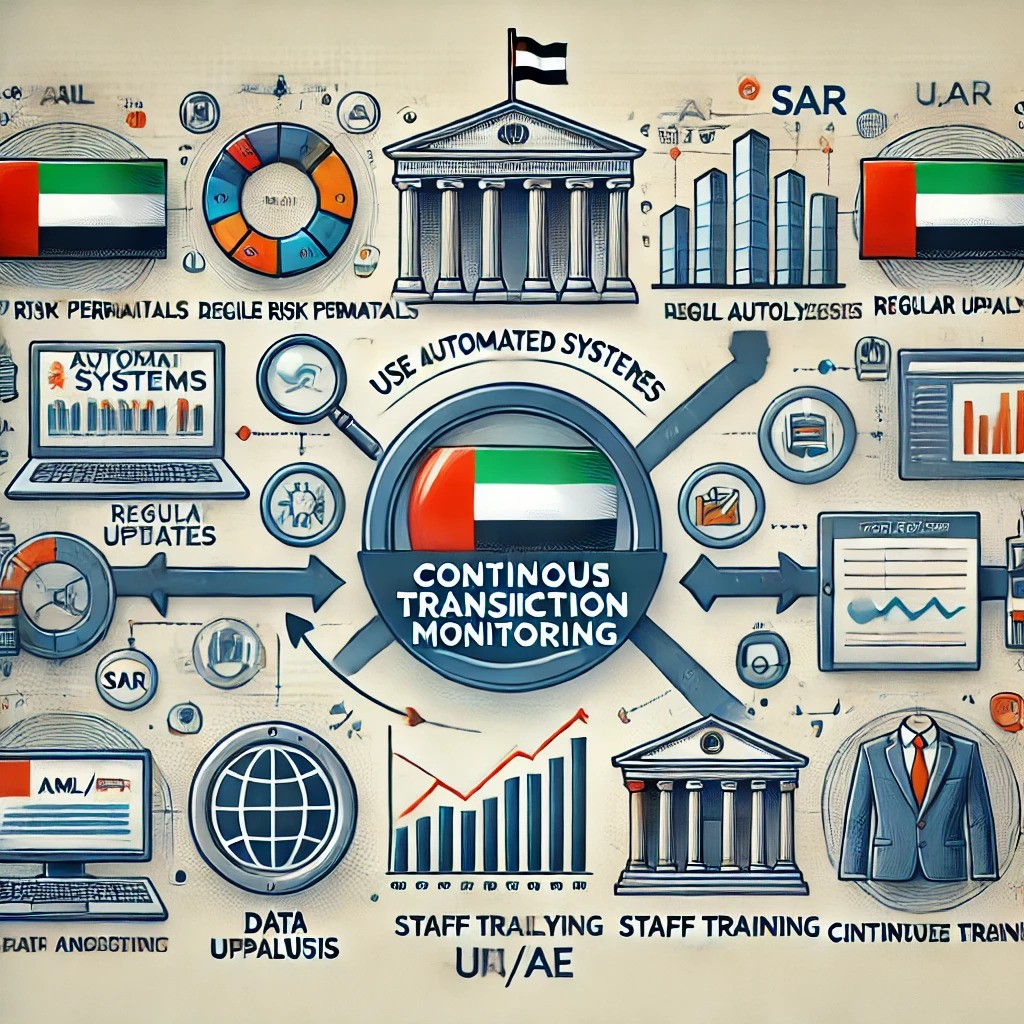How to do continuous Transactions Monitoring in AML/CFT in UAE
Publish On : 10-08-2024

Continuous transaction monitoring is an essential process in AML/CFT compliance that involves the ongoing review of customer transactions to detect any unusual or suspicious activities. In the UAE, the regulations and guidelines set forth by various authorities, such as the Central Bank of UAE (CBUAE) and the UAE Financial Intelligence Unit (UAE FIU), emphasize the importance of continuous monitoring to ensure compliance with AML/CFT laws.
Here’s how you can implement continuous transaction monitoring effectively:
Establish a Risk-Based Approach (RBA):
Risk Assessment: Begin by assessing the risk level of each customer based on factors such as their geographical location, business activity, transaction patterns, and history. Article 5 of the Federal Decree-Law No. (20) of 2018 emphasizes the importance of conducting risk assessments to identify, assess, and understand the risks of money laundering and terrorist financing.
Customer Segmentation: Based on the risk assessment, segment customers into different risk categories (e.g., low, medium, high). This allows for prioritizing monitoring efforts.
Automated Transaction Monitoring Systems:
Use software systems designed to monitor transactions continuously. These systems should be capable of identifying patterns, anomalies, or red flags based on predefined rules and thresholds.
Scenario-Based Monitoring: Develop scenarios tailored to different types of risks. For example, for high-risk customers, the system should flag any large, rapid, or unexpected transactions.
Real-Time and Post-Transaction Monitoring:
Real-Time Monitoring: Implement real-time monitoring to detect suspicious activities as they happen. This is crucial for preventing potential money laundering or terrorist financing activities before they are completed.
Post-Transaction Monitoring: Regularly review completed transactions to detect any patterns of suspicious behavior that may not have been identified in real-time.
Periodic Review and Updating of Monitoring Rules:
Continuously update the monitoring rules and thresholds based on evolving risks and regulatory requirements. Regularly review the effectiveness of the monitoring system and make necessary adjustments.
Investigation and Reporting:
When the system flags a suspicious transaction, conduct an immediate investigation. Review the customer’s profile, history, and the context of the transaction.
If the suspicion is confirmed, file a Suspicious Transaction Report (STR) with the UAE FIU as required by Article 15 of Cabinet Decision No. (10) of 2019.
Documentation and Audit Trail:
Maintain comprehensive records of all monitored transactions, investigations, and the actions taken. This documentation should be accessible for internal audits and regulatory inspections.
Training and Awareness:Work closely with other financial institutions and relevant authorities to share information on emerging threats and typologies. Collaborative efforts enhance the effectiveness of transaction monitoring. By following these steps, organizations can establish a robust continuous transaction monitoring framework that aligns with UAE’s AML/CFT regulations, helping to detect and prevent illicit financial activities. Legal References:
Work closely with other financial institutions and relevant authorities to share information on emerging threats and typologies. Collaborative efforts enhance the effectiveness of transaction monitoring.
By following these steps, organizations can establish a robust continuous transaction monitoring framework that aligns with UAE’s AML/CFT regulations, helping to detect and prevent illicit financial activities.
Regularly train your staff on the latest AML/CFT regulations, red flags, and the use of transaction monitoring systems. Staff awareness is critical in identifying and responding to suspicious activities effectively.
Collaboration and Information Sharing:
Work closely with other financial institutions and relevant authorities to share information on emerging threats and typologies. Collaborative efforts enhance the effectiveness of transaction monitoring.
By following these steps, organizations can establish a robust continuous transaction monitoring framework that aligns with UAE’s AML/CFT regulations, helping to detect and prevent illicit financial activities.
This blog is for educational purposes only. Errors and omissions are expected. For detailed advisory, additional clarifications, or formal opinions, please reach out to our team of experts at Sheikh Anwar Accounting & Auditing LLC (info@sa-auditors.com) or contact us at +97143290586 and log in at www.sa-auditors.com.
Recent Articles

The Ultimate Guide To Selecting External Auditors
Publish On : 30-07-2024

"The Importance of Regular Anti-Money Laundering Audits"
Publish On : 31-07-2024

List of VAT-Exempt Goods and Services in UAE
Publish On : 01-08-2024

How Transaction Monitoring Improves AML Compliance
Publish On : 02-08-2024

Navigating the AML Software Landscape
Publish On : 02-08-2024

Economic Substance in the UAE
Publish On : 19-07-2024

AML Compliance Services in Dubai, UAE
Publish On : 22-07-2024
